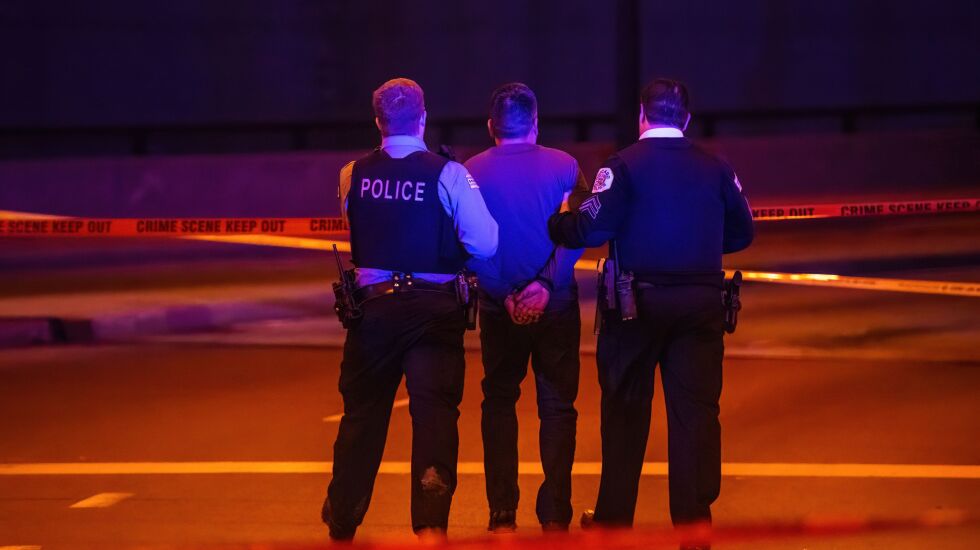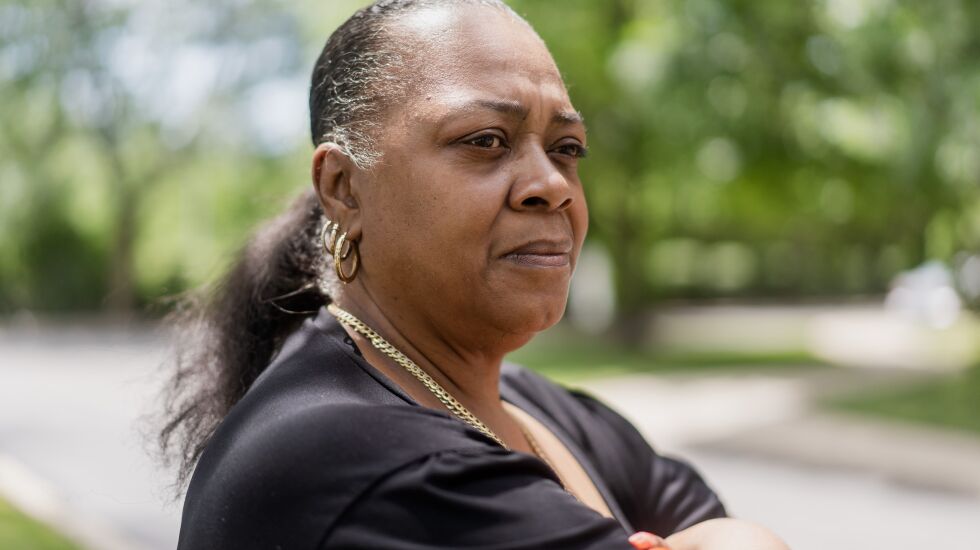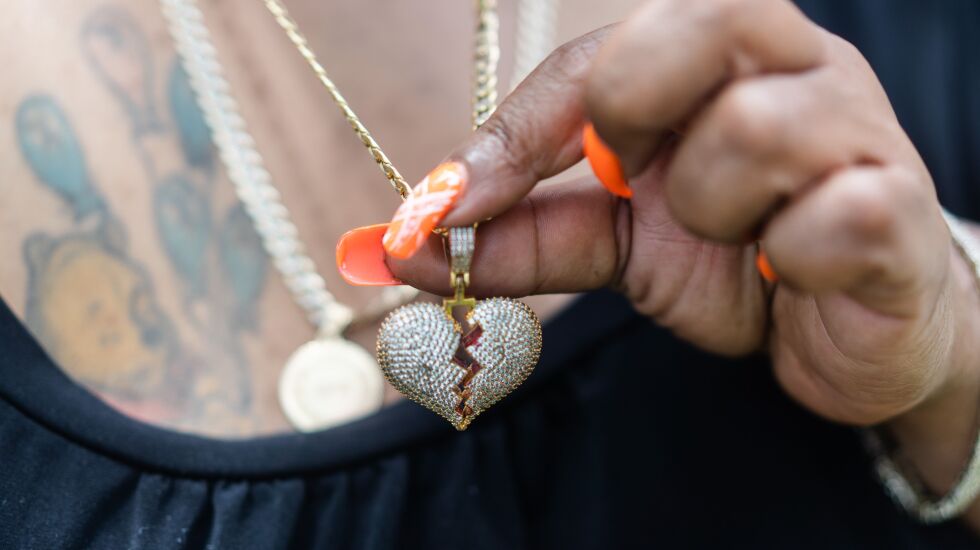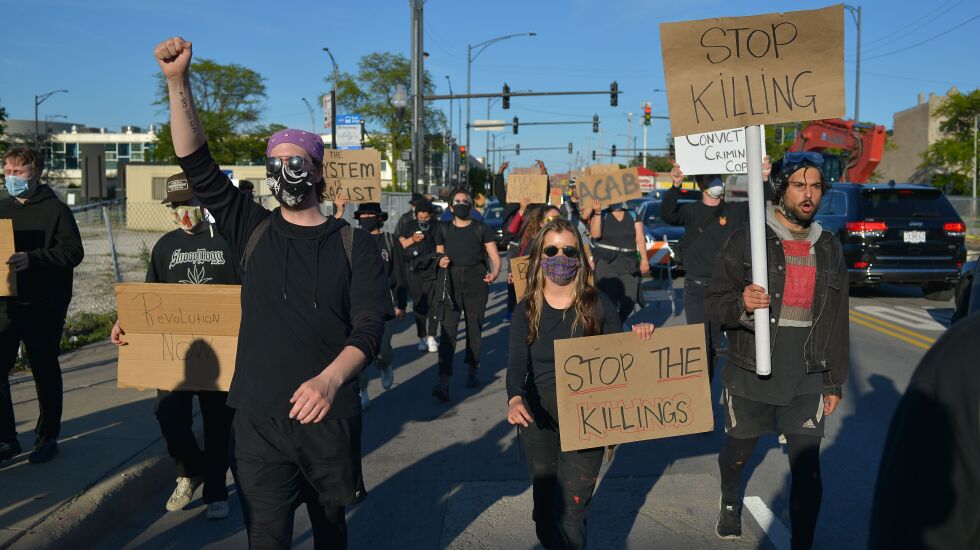
Her eldest, 20-year-old Tyler “Ty Ty” Malden, was shot in the head and an arm on April 6, 2020, targeted in a drive-by attack in an alley in the 10000 block of South Torrence Avenue.
As rumors drifted through the neighborhood, Gordon says a young man began “bragging on Facebook that he did the murder.”
Her other son, 15-year-old Terrance “Munchie” Malden, joined a chorus of neighbors who spoke out about the man’s claims.
Months later, that July 10, Terrance was killed, struck in the back in a drive-by shooting in an alley in the 9800 block of South Hoxie Avenue, blocks from where his brother was slain.
Gordon thinks the person who claimed responsibility for Tyler’s killing had a hand in Terrance’s death, too. She says the man has been harassing the family, stealing a poster from Gordon’s front yard memorializing her sons, then posting a photo to Instagram showing him aiming at it with a handgun equipped with an extended magazine.
Gordon says it’s “frustrating to the utmost” that Chicago police detectives haven’t been able to make a case. Updates from detectives have been infrequent, she says, and it’s difficult to get them on the phone.

“The only thing they can tell me is that it’s an open case. ‘We’re still waiting for witnesses to come forward,’ ” she says. “That’s it. That’s the end of the conversation. Oh, and, ‘I’m sorry that you had to deal with this and [your] loss.’ ”
In the years since Gordon’s sons were killed, violent crime in Chicago has continued to surge — and criminals are mostly getting away with it.
The police have made arrests in just 12% of crimes reported last year, according to a Chicago Sun-Times analysis. That’s the lowest level since at least 2001, the first year the data was made publicly available.
The overall arrest rate peaked at nearly 31% in 2005 and has dropped steadily.
The decline in arrests mirrors a drop in nearly every category of police officers’ activity tracked by the Chicago Police Department. The numbers of traffic stops, tickets and investigative stops — in which pedestrians are patted down or searched by officers on the street — all have plummeted. The number of investigative stops dropped by more than half between 2019 and last year, falling from 155,000 citywide to 69,000.
And fewer crimes overall are getting reported — by victims and by the police, who used to produce many crime reports themselves while patrolling their beats.
The slowdown amounts to a pullback by police officers as the city has experienced its most violent years in decades, a rise also seen in other major U.S. cities during the coronavirus pandemic and in the wake of the 2020 death of George Floyd at the hands of a Minneapolis police officer.
Rank-and-file police who patrol the streets and even top brass say officers are doing less.
Even just the suggestion that this was the case was once controversial. Former Mayor Rahm Emanuel caused a minor scandal in 2014 when he told a gathering of big city police chiefs and Justice Department officials that cops had “gone fetal” in response to growing public scrutiny.
John Catanzara, president of Fraternal Order of Police Lodge 7, even says officers aren’t as active as they once were.
Contributing factors include:
- The pandemic.
- Dramatic shifts in strategy from the top.
- Increased scrutiny of the police.
- Cops saying they increasingly feel that making an arrest isn’t worth risking their lives, their jobs or becoming a viral news villain.
There also was a plunge in the number of arrests for so-called index crimes, which include homicide, sexual assault, robbery and aggravated battery.
Officers made arrests in fewer than 6% of those crime categories that were reported last year, the lowest level since at least 2001, the Sun-Times analysis of Chicago police data found. The trend has continued this year, according to figures through early June.
For the early years covered by the data, arrest rates are higher for killings, shootings and sexual assaults because detectives have had more time to solve those cases.
Still, arrests typically are made in the month or year that a crime was committed, law enforcement officials say. The data analyzed by the Sun-Times doesn’t show when an arrest took place — whether it was in the year a crime was committed or later on.
Cops admit pulling back
In 2019, as the overall arrest rate continued to fall, City Hall agreed to a federal consent decree aimed at overhauling the police department following the killing by a police officer of 17-year-old Laquan McDonald in 2014 on the Southwest Side.
The department has since made reforms aimed at changing how officers do their jobs, including a stricter vehicle pursuit policy and a new foot pursuit policy.
Also, cops have been told to stop enforcing some low-level offenses, including the possession of small amounts of marijuana, which was legalized in Illinois as of the start of 2020.
But the number of arrests for possessing harder drugs, like heroin, also has fallen significantly. Those arrests peaked at 7,753 in 2001 but dropped last year to 929.
‘We can only support each other at the lowest ranks,’ says one officer. ‘And if that means going out there and not doing anything, then that means going out there and not doing anything.’
Current and former police officers — who agreed to speak on the condition they not be identified — say cops have been pulling back for other reasons.
A former commander says officers who regularly have had days off canceled are avoiding making some arrests because they don’t want to wind up in court during their time off.
A beat cop who patrols downtown says prosecutors’ high threshold for approving felony charges has made officers second-guess whether to engage “criminals with guns” — a sentiment the former commander echoes.
The beat cop says high-profile attacks on officers such as last August’s shooting in West Englewood that left Ella French dead and her partner Carlos Yanez critically wounded — “make us take a step back and think: Who really cares about us at that point?
“We can only support each other at the lowest ranks,” the officer says. “And if that means going out there and not doing anything, then that means going out there and not doing anything.”

Rank-and-file officers, sergeants and detectives also say they feel they have a target on their backs. They point to the consent decree, which requires the city to reform its policing policies after the Justice Department found officers engaged in civil rights violations.
Veteran cops say they used to go out of their way to make arrests when they saw suspicious activity but that they’re less likely to now for fear of getting into trouble and being fired or even arrested.
“In the past, I might see a guy with a gun in his waistband, and I’d jump out and chase him,” one decorated officer says. “No way I’d do that now.”
If that same person were involved in a shooting, though, that officer says he would always take action.
But the data shows those fears largely are unfounded despite high-profile incidents of cops being punished or facing blowback for actions in the line of duty. As the number of arrests has declined, fewer officers have been fired or suspended for misconduct.
In 2012, 10 officers were fired, nine were suspended, and nine resigned while facing misconduct accusations. Last year, three officers were fired and one suspended, with four resigning under a cloud.
‘A big trust issue’
In the South Chicago Police District, where LaTanya Gordon’s sons were killed two years ago, the arrest rate fell by 64% between 2019 and 2021, the largest decrease in any district in that period. The rate has increased slightly this year as crime has risen significantly.
Gordon points to “this silence that the neighborhood gives,” noting that many people are afraid to help the cops “because they don’t want retaliation to knock on their door.”
“If it happens at your front door, wouldn’t you want someone to let your family members know what’s going on and get justice for your family member?” she says.

She says “quite a few people” have details about her sons’ fatal shootings — including information about the person she believes was involved. Detectives have dismissed it as “hearsay” and won’t move forward without witnesses, she says.
“It’s nothing that no one is trying to make up, but it’s something to which we have been hearing,” she says. “So, if seven or eight people are telling you this person’s name … wouldn’t you wanna know who this person is?”
James Sims, a program manager with Communities Partnering 4 Peace, an anti-violence group that works in the area, says the drop in arrests stems from “a big trust issue.”
Sims says police shootings have eroded the already-tenuous relationship between cops and the communities they serve. People have used Chicago Alternative Policing Strategy — CAPS — community policing meetings to raise concerns about what officers are doing, some voicing frustration that officers aren’t addressing “loitering and hanging out.”
Sims remembers the days of officers walking a beat, joining people at block parties and going door-to-door to check on community “elders,” saying that’s the type of outreach people want.
“They’ve gotta get back to where it used to be when you had officers engaging with people in the community,” he says. “You don’t even have that anymore. If you have more engagement, you have better solutions.”
‘The Ferguson effect’
Some studies have shown that, when police make fewer arrests and stops because of mandates from supervisors or increased oversight or even in the wake of an officer’s death, the number of low-level arrests tumble with no effect on violent crime — even when the drop in police activity is significant.
When police pull back after a high-profile killing by officers, though, the number of serious crimes surge, according to Deepak Premkumar, a researcher who has studied links between policing scandals and crime.
“What comes through is that context matters, the context of this decline in police activity and arrests,” Premkumar says. “When there is a high-profile event, the community scrutiny increases, [police] activity drops.”
The phenomenon has become known as “The Ferguson Effect,” named for the St. Louis suburb where police pulled back and violence rose in 2014 after an officer shot and killed 18-year-old Michael Brown.
The reasons include officers cutting back on their activity and community members becoming less likely to cooperate with police, Premkumar says.
A similar situation was seen in Baltimore in 2015 after officers were charged in the death of Freddie Gray, and in Chicago the same year after the release of video showing Officer Jason Van Dyke fatally shooting McDonald, according to Premkumar, who made McDonald’s killing the focus of a study on the impact of high-profile police shootings on crime and policing.
The nationwide protests sparked by the killing of Floyd, a Black man, by a white Minneapolis cop in 2020 — amid pandemic lockdowns in many cities — could have had similar effects on police and community behavior across the country, according to Premkumar.
“There are so many factors related to the pandemic that could have led police to pull back and for crimes to increase,” Premkumar says. “But it’s entirely possible that the murder of George Floyd, the highest-profile [police killing] in U.S. history, played a role in increases in crime.”

Jens Ludwig, a director of the Crime Lab at the University of Chicago, says evidence suggests “public safety is more a function about the quality — rather than the quantity — of arrests.”
Ludwig says his research has found that making a great number of arrests for low-level misdemeanors, like weed possession, “has very little public safety benefit.”
But making more arrests in homicides and shootings “can have a substantial effect in reducing gun violence” because they can “head off cycles of retaliation” among friends and family who otherwise might “take things into their own hands,” fearing the justice system doesn’t hold shooters accountable, Ludwig says.
“The implication is that you can achieve public safety by doing a lot of arrests or achieve the same level of public safety by doing lots fewer arrests and thereby imposing much less harm on society created by the criminal justice system itself,” he says. “It seems to be differences in the quality of police department management and leadership that determines which set of outcomes you get.”
Mayor: I don’t see a work stoppage
Mayor Lori Lightfoot and police Supt. David Brown have said city officials “cannot arrest our way out of” the violence that disproportionately affects minority communities on the South Side and the West Side.
But, in January, days after closing the books on the city’s deadliest year in a quarter-century, Lightfoot and Brown threatened to demote police supervisors if they couldn’t boost the department’s flagging arrest numbers and get officers to engage more with city residents.
Police sources have said a new emphasis was then placed on comparing officer activity to 2019, the year Lightfoot took office.
Members of tactical units — who respond to gunfire and gang disturbances — soon faced heightened scrutiny, and most of them were sent to work in beat cars.
Brown blamed their redeployment on staffing issues related to a surge in COVID-19 cases, though sources said it was based on officers’ performance.
In early February, more than 300 officers, including 211 from tactical teams, were reassigned to patrol streets as the department struggled to bolster arrests and combat violence amid a hiring slowdown and a flood of retirements.
The officers who were reassigned had the lowest number of arrests dating to last year, sources said.
At the time, a mayoral spokesman confirmed that tactical officers were being reassigned because they were “seriously under-performing.”
Lightfoot and Brown now decline to answer questions about the low arrest rate for major crimes.
In separate interviews, they say the police department has shifted from enforcing low-level offenses and tout what they see as more important measures of success, such as the record number of guns recovered last year.

Brown says higher arrest rates in the past were a byproduct of a troubled era typified by “stopping and frisking and mass incarcerating people of color.
“I’ve been doing this 40 years, and the highest arrest rates in the ‘80s and ‘90s did not make us safer,” the superintendent says. “It was a flawed policing model.”
Lightfoot says officers are “still running towards danger” and not in any way shirking their duties or pulling back from making arrests.
“Is this a difficult time to be the police? No question,” she says. “Are there officers that are concerned about being that next viral video? No question. Is that a widespread sentiment, so it leads to the conclusion that you’re suggesting that it’s in effect a work stoppage? I’m not seeing that.”
It isn’t only the numbers of low-level offenses that have seen a drop. Arrest rates for robberies fell to 4.6% of all cases, half the 2001 level, and, for aggravated battery, the number plunged to 11.6% of cases from 21.4% in 2001.
Ald. Ray Lopez (14th), one of Lightfoot’s fiercest critics, says the responsibility for the department’s low number of arrests falls on the mayor and the superintendent, who have “driven away officers” and caused “a personnel crisis within the department.”
Brown’s recent emphasis on officer wellness has been undercut by the department’s decision to routinely cancel cops’ days off, according to Lopez. “Overworked” cops are having a difficult time responding to 911 calls, frustrating people in communities across the city who are looking for help and ultimately leading to fewer arrests, says Lopez, who is one of several candidates seeking Lightfoot’s job in next year’s mayoral election.
Lopez, who has spoken out against gang crimes in his Brighton Park neighborhood, also says detectives have been sent to stand on corners in “high-profile areas just to provide bodies,” which he says is a misuse of valuable resources.
“Those detectives need to be solving crimes,” Lopez says. “They don’t need to be babysitting high-value targets. And that has also led us, our department, not being able to arrest the individuals, follow up on leads and find out who’s doing what in our neighborhoods.”

More detectives?
As Chicago and other cities have seen arrest numbers plummet, one possible response that’s come up is: Hire more detectives.
The Chicago Police Department has about 180 homicide detectives and is aiming to increase that number to reflect a national standard of three to five murder cases per homicide detective, according to a police spokeswoman.
The total number of detectives — including homicide detectives and those who investigate theft and other less serious crimes — is about 1,085, not including supervisors, according to statistics posted on the city inspector general’s website.
Nationally, a bill in Congress would provide $1 billion a year over 10 years to hire more detectives to focus on murders and nonfatal shootings, along with improving technology available to investigators and helping the families of crime victims.
For now, Lopez says, cops are “unquestionably hesitating and slowing down.
“As fewer arrests are made, the legitimacy of law enforcement gets questioned in the eyes of the people, the less respect people have for law enforcement because they feel and, quite literally, see that you can get away with almost anything in this city right now and not get caught,” he says. “Refusal to recognize that fact only makes Chicago all the more dangerous.”







